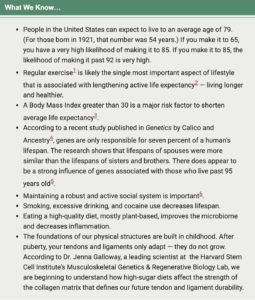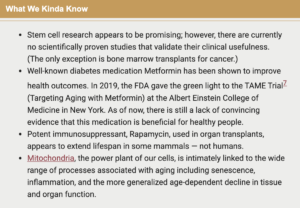
In the last issue, we introduced the concept of longevity and healthspan. To recap, in the field of demography, the term longevity is usually defined as a synonym for ‘life expectancy.’ In consumer terms, longevity refers to the capability to survive past the average age of death (whereas life expectancy is the average number of years remaining at a given age). In October we also discussed healthspan, defined as the amount of your time spent in optimal health, without disease or suffering.
The science of longevity is only just beginning to accelerate. In our current moment, here is what to look out for:



Who is marketing to the idea of longevity — both with products and ideas?
As a clinician with the hindsight of 20 years in the field, I see the pattern of medical fads, pop-up experts, and the unsettling promotion of pseudo-science. The key lesson is this: great marketing on top of pseudoscience always prevails over poor marketing on top of great science. In addition, the population interested in living longer is no longer confined to the AARP crowd. Millennials are getting into the longevity game (think keto diets, biohacking, fat-laden coffee, etc). The triple effects of social media, fake news, and ego-hungry influencers combined with a proliferation of scientific advances makes for a perfect platform for modern-day marketers (a.k.a. gurus) to fuel a booming, if suspect, ‘longevity’ industry.
The first rule of identifying gurus is understanding personalities. If you hear about some new ‘treatment’ or ‘cure’ or ‘method,’ first ask yourself, is it being promoted by a single individual? If yes, dig deeper and search for the academic medical center validation or the peer-reviewed clinical trials that underpin their schtick. Likely, you will not find it; or if you do, see if the research was done on humans or animals. It is critical to remember that animal physiology may appear similar to humans, but it is not. Chocolate is toxic to dogs and can kill them8.
The second rule of the guru is to look carefully into the claims they are making. In the world of real science, there is always a nod to the risk profile of any intervention. That is, what is the downside? We’ve all seen the pharmaceutical ads on TV where there is a scene of a sunny day with a child running through the field of flowers — only to end with a rapid, fine print rap about nausea, life-threatening blood disorders, blindness, and other risks. In the world of promoting pseudoscience, there is no risk — it’s all benefit and all money in someone’s pocket.
The third rule in the guru playbook is the tendency for them to belittle real scientists for not being ‘forward-thinking.’
Any intervention directly interacting with your physiology, and therefore your long-term health, warrants assiduous due diligence. It is dicey to rely on the fascinating anecdotes promulgated by ‘cocktail medicine’ or ‘podcast medicine.’ Be smart and recognize that there is no such thing as ‘all upside’ — there is always a downside lurking in guru medicine, it’s just neither touted nor promoted.
In a world finally grappling with the realities of COVID and mortality, there are many interesting claims and stories written about aging, biological clocks, and biohacks. There are kernels of truth in all of them; this is what makes the guru believable: their selective choice of which fact and study to contextualize their pitch.
In the next issue of The Physician, we will attempt to unpack these claims; specifically where they intersect with lifestyle, technology, and products. In the end, the quality of our life now is as important as the quality of life of our future self.
Note: as many things as there are ‘to do’ in order to live longer, there is an equally long list of things ‘not to do’ to live a long and healthy life.

